Improving the Efficiency of the Shunt Active Power Filter Acting with the Use of the Hysteresis Current Control Technique
Abstract
:1. Introduction
2. Method for Obtaining the Reference Signal
3. The Model of the Source–Load–Active Filter System
4. Continuous and Discontinuous Use of the DC-Link Capacitor Energy
4.1. Shaping the Source Current with Continuous Use of DC-Link Capacitor Energy
- (a)
- vS ≥ 0 and PA-NB pair is in state ON;
- (b)
- vS ≥ 0 and NA-PB pair is in state ON;
- (c)
- vS < 0 and PA-NB pair is in state ON;
- (d)
- vS < 0 and NA-PB pair is in state ON.
- -
- Combination (a): vS ≥ 0 and PA-NB pair is in state ON
- -
- Combination (b): vS ≥ 0 and NA-PB pair is in state ON
- -
- Combination (c): vS < 0 and PA-NB pair is in state ON
- -
- Combination (d): vS < 0 and NA-PB pair is in state ON
4.2. Shaping the Source Current with Discontinuous Use of DC-Link Capacitor Energy
- tON,NA-PB < tON,PA-NB;
- The sign of the total voltage in the denominator of expression (22) is consistent with the sign of the source voltage and, on the contrary, in the denominator of expression (23) is the opposite.
- tON,NA-PB < tON,PA-NB;
- The sign of the total voltage in the denominator of expression (24) is opposite the sign of the source voltage, but consistent in the denominator of expression (25).
- tON,NA-PB = tON,PA-NB;
- The sum of both periods tON,NA-PB + tON,PA-NB is the smallest, i.e., the switching frequency is the highest in this case;
- The case discussed here concerns a supply voltage that is close to zero
5. Logic System for Three-State Control Technique σ ϵ (+1, −1, 0)
6. Two- or Three-State Control Technique vs. Conductance Signal Accuracy
6.1. Conductance Signal Accuracy
6.2. DC-Link Capacitor Lifetime
7. Conclusions
- –
- Energy loss in the switching elements and the DC-link capacitor is reduced;
- –
- Operating temperature of switches and other elements of the active filter can be diminished;
- –
- Current ripples in the DC-link capacitor decrease;
- –
- DC-link capacitor lifetime increases;
- –
- High-frequency components in supply voltage/current waveforms decrease.
Funding
Data Availability Statement
Conflicts of Interest
References
- Bollen, M. What is power quality? Electr. Power Syst. Res. 2003, 66, 5–14. [Google Scholar] [CrossRef]
- Sharmaa, A.; Rajpurohita, B.S.; Singh, S.N. A review on economics of power quality: Impact, assessment and mitigation, Renewable and Sustainable. Energy Rev. 2018, 88, 363–372. [Google Scholar]
- Caramia, P.; Carpinelli, G.; Verde, P. Power Quality Indices in Liberalized Markets; John Wiley & Sons: Hoboken, NJ, USA, 2009. [Google Scholar]
- Zhang, X.-P.; Yan, Z. Energy Quality: A Definition. IEEE Open Access J. Power Energy 2020, 7, 430–440. [Google Scholar] [CrossRef]
- Benysek, G.; Kazmierkowski, M.P.; Popczyk, J.; Strzelecki, R. Power electronic systems as a crucial part of Smart Grid infrastructure—A survey. Bull. Pol. Acad. Sci. Tech. Sci. 2011, 59, 455–473. [Google Scholar] [CrossRef]
- Dixon, J.W.; Ooi, B.T. Indirect current control of a unity power factor sinusoidal current boost type three-phase rectifier. IEEE Trans. Ind. Electr. 1988, 35, 508–515. [Google Scholar] [CrossRef]
- Garcia, O.; Cobos, J.; Prieto, R.; Alou, P.; Uceda, J. Single Phase Power Factor Correction: A Survey. IEEE Trans. Power Electron. 2003, 18, 749–755. [Google Scholar] [CrossRef]
- Kolar, J.; Friedli, T. The Essence of Three-Phase PFC Rectifier Systems—Part I. IEEE Trans. Power Electron. 2013, 28, 176–198. [Google Scholar] [CrossRef]
- Friedli, T.; Hartmann, M.; Kolar, J. The Essence of Three-Phase PFC Rectifier Systems—Part II. IEEE Trans. Power Electron. 2013, 29, 543–560. [Google Scholar] [CrossRef]
- Nguyen, H.-N.; Nguyen, M.-K.; Duong, T.-D.; Tran, T.-T.; Young-Cheol Lim, Y.-C.; Choi, J.-H. A Study on Input Power Factor Compensation Capability of Matrix Converters. Electronics 2020, 9, 82. [Google Scholar] [CrossRef]
- Sannio, A.; Svensson, J.; Larsson, T. Power-electronic solutions to power quality problems. Electr. Power Syst. Res. 2003, 66, 71–82. [Google Scholar] [CrossRef]
- Awad, H.; Bollen, M. Power electronics for power quality improvements. In Proceedings of the IEEE International Symposium on Industrial Electronics, Rio de Janeiro, Brazil, 9–11 June 2003. [Google Scholar]
- Alfonso, J.L.; Tanta, M.; Pinto, J.G.; Monteiro, L.F.; Machado, L.; Sousa, T.J.; Monteiro, V. A Review on Power Electronics Technologies for Power Quality Improvement. Energies 2021, 14, 8585. [Google Scholar] [CrossRef]
- Szulborski, M.; Kolimas, Ł.; Łapczyński, S.; Szczęśniak, P. Single phase UPS systems loaded with nonlinear circuits: Analysis of topology in the context of electric power quality. Arch. Electr. Eng. 2019, 68, 787–802. [Google Scholar] [CrossRef]
- Green, T.C.; Marks, J.H. Control techniques for active power filters. IEEE Proc. Power Appl. 2005, 152, 369–381. [Google Scholar] [CrossRef]
- Asiminoaei, L.; Blaabjerg, F.; Hansen, S. Detection is key. Harmonic detection methods for active power filter applications. IEEE Ind. Appl. Mag. 2007, 13, 22–33. [Google Scholar] [CrossRef]
- Bhattacharya, A.; Chakraborty, C.; Bhattacharya, S. Shunt compensation. Reviewing traditional methods of reference current generation. IEEE Ind. Electron. Mag. 2009, 3, 38–49. [Google Scholar] [CrossRef]
- Revuelta, P.S.; Litran, S.P.; Thomas, J.P. Active Power Line Conditioners Design, Simulation and Implementation for Improving Power Quality; Academic Press: Cambridge, MA, USA; Elsevier: Amsterdam, The Netherlands, 2016. [Google Scholar]
- Sozański, K. Digital Signal Processing in Power Electronics Control Circuits; Springer: Berlin/Heidelberg, Germany, 2017. [Google Scholar]
- Benysek, G.; Pasko, M.; Maciążek, M.; Sozański, K.; Jarnut, M.; Kaniewski, J. Power Theories for Improved Power Quality; Springer: Berlin/Heidelberg, Germany, 2012. [Google Scholar]
- Xia, Y.; Roy, J.; Ayyanar, R. Optimal Variable Switching Frequency Scheme to Reduce Loss of Single-Phase Grid-Connected Inverter With Unipolar and Bipolar PWM. IEEE J. Emerg. Sel. Top. Power Electron. 2019, 9, 1013–1026. [Google Scholar] [CrossRef]
- Zygmanowski, M.; Grzesik, B.; Fulczyk, M.; Nalepa, R. Analytical and Numerical Power Loss Analysis in Modular Multilevel Converter. In Proceedings of the IECON 2013—39th Annual Conference of the IEEE Industrial Electronics Society, Vienna, Austria, 10–13 November 2013. [Google Scholar]
- Zygmanowski, M. Detailed Power Loss Analysis of T-Type Neutral Point Clamped Converter for Reactive Power Compensation. Electronics 2022, 11, 2129. [Google Scholar] [CrossRef]
- Oeder, C.; Barwig, M.; Duerbaum, T. Estimation of Switching Losses in Resonant Converters Based on Datasheet Information. In Proceedings of the 2016 18th European Conference on Power Electronics and Applications (EPE’16 ECCE Europe), Karlsruhe, Germany, 5–9 September 2016. [Google Scholar]
- Asiminoaei, L.; Rodriguez, P.; Blaabjerg, F.; Malinowski, M. Reduction of Switching Losses in Active Power Filters With a New Generalized Discontinuous-PWM Strategy. IEEE Trans. Ind. Electron. 2008, 55, 467–471. [Google Scholar] [CrossRef]
- Gurpinar, E.; Castellazzi, A. Single-Phase T-Type Inverter Performance Benchmark Using Si IGBTs, SiC MOSFETs, and GaN HEMTs. IEEE Trans. Power Electron. 2016, 31, 7148–7160. [Google Scholar] [CrossRef]
- Szular, Z.; Rozegnał, B.; Mazgaj, W. A New Soft-Switching Solution in Three-Level Neutral-Point-Clamped Voltage Source Inverters. Energies 2021, 14, 2247. [Google Scholar] [CrossRef]
- Sojka, P.; Pipiska, M.; Frivaldski, M. GaN power transistor switching performance in hard-switching and soft-switching modes. In Proceedings of the 2019 20th International Scientific Conference on Electric Power Engineering (EPE), Kouty nad Desnou, Czech Republic, 15–17 May 2019. [Google Scholar]
- Oswald, N.; Anthony, P.; McNeill, N.; Stark, B.H. An Experimental Investigation of the Tradeoff between Switching Losses and EMI Generation With Hard-Switched All-Si, Si-SiC, and All-SiC Device Combinations. IEEE Trans. Power Electron. 2014, 29, 2393–2407. [Google Scholar] [CrossRef]
- Bazzi, A.M.; Krein, P.T.; Kimball, J.W.; Kepley, K. IGBT and Diode Loss Estimation Under Hysteresis Switching. IEEE Trans. Power Electron. 2012, 27, 1044–1048. [Google Scholar] [CrossRef]
- Buso, S.; Malesani, L.; Mattavelli, P. Comparision of Current Control Techniques for Active Filter Applications. IEEE Trans. Ind. Electron. 1998, 45, 722–729. [Google Scholar] [CrossRef]
- Kale, M.; Ozdemir, E. An adaptive hysteresis band current controller for shunt active power filter. Electr. Power Syst. Res. 2005, 73, 113–119. [Google Scholar] [CrossRef]
- Awasthi, A.; Patel, D. Implementation of Adaptive Hysteresis Current Control Technique for Shunt Active Power Conditioner and Its Comparison with Conventional Hysteresis Current Control Technique. In Proceedings of the 2017 IEEE International Conference on Signal Processing, Informatics, Communication and Energy Systems (SPICES), Kollam, India, 8–10 August 2017. [Google Scholar]
- Kaźmierkowski, M.; Malesani, L. Current Control Techniques for Three-Phase Voltage-Source PWM Converters: A Survey. IEEE Trans. Ind. Electron. 1998, 45, 691–703. [Google Scholar] [CrossRef]
- Szromba, A. Is It Possible to Obtain Benefits by Reducing the Contribution of the Digital Signal Processing Techniques to the Control of the Active Power Filter? Energies 2021, 14, 6031. [Google Scholar] [CrossRef]
- Depenbrock, M.; Staudt, V. The FBD-method as tool for compensating non-active currents. In Proceedings of the 8th Inter-national Conference on Harmonics and Quality of Power, Athens, Greece, 14–16 October 1998; pp. 320–324. [Google Scholar]
- Peyghami, S.; Blaabjerg, F.; Palensky, P. Incorporating Power Electronic Converters Reliability Into Modern Power System Reliability Analysis. IEEE J. Emerg. Sel. Top. Power Electron. 2021, 9, 1668–1681. [Google Scholar] [CrossRef]
- Yang, S.; Xiang, D.; Bryant, A.; Mawby, P.; Ran, L.; Tavner, P. Condition Monitoring for Device Reliability in Power Electronic Converters: A Review. IEEE Trans. Power Electron. 2010, 25, 2734–2752. [Google Scholar] [CrossRef]
- Wang, H.; Blaabjerg, F. Reliability of Capacitors for DC-Link Applications in Power Electronic Converters—An Overview. IEEE Trans. Ind. Appl. 2014, 50, 3569–3578. [Google Scholar] [CrossRef]
- Kim, Y.-J.; Kim, S.-M.; Lee, K.-B. Improving DC-Link Capacitor Lifetime for Three-Level Photovoltaic Hybrid Active NPC Inverters in Full Modulation Index Range. IEEE Trans. Power Electron. 2021, 36, 5250–5261. [Google Scholar] [CrossRef]
- Sharma, P.K.; Vijayakumar, T. Study of Capacitor & Diode Aging effects on Output Ripple in Voltage Regulators and Prognostic Detection of Failure. Intl. J. Electron. Telecommun. 2022, 68, 281–286. [Google Scholar]
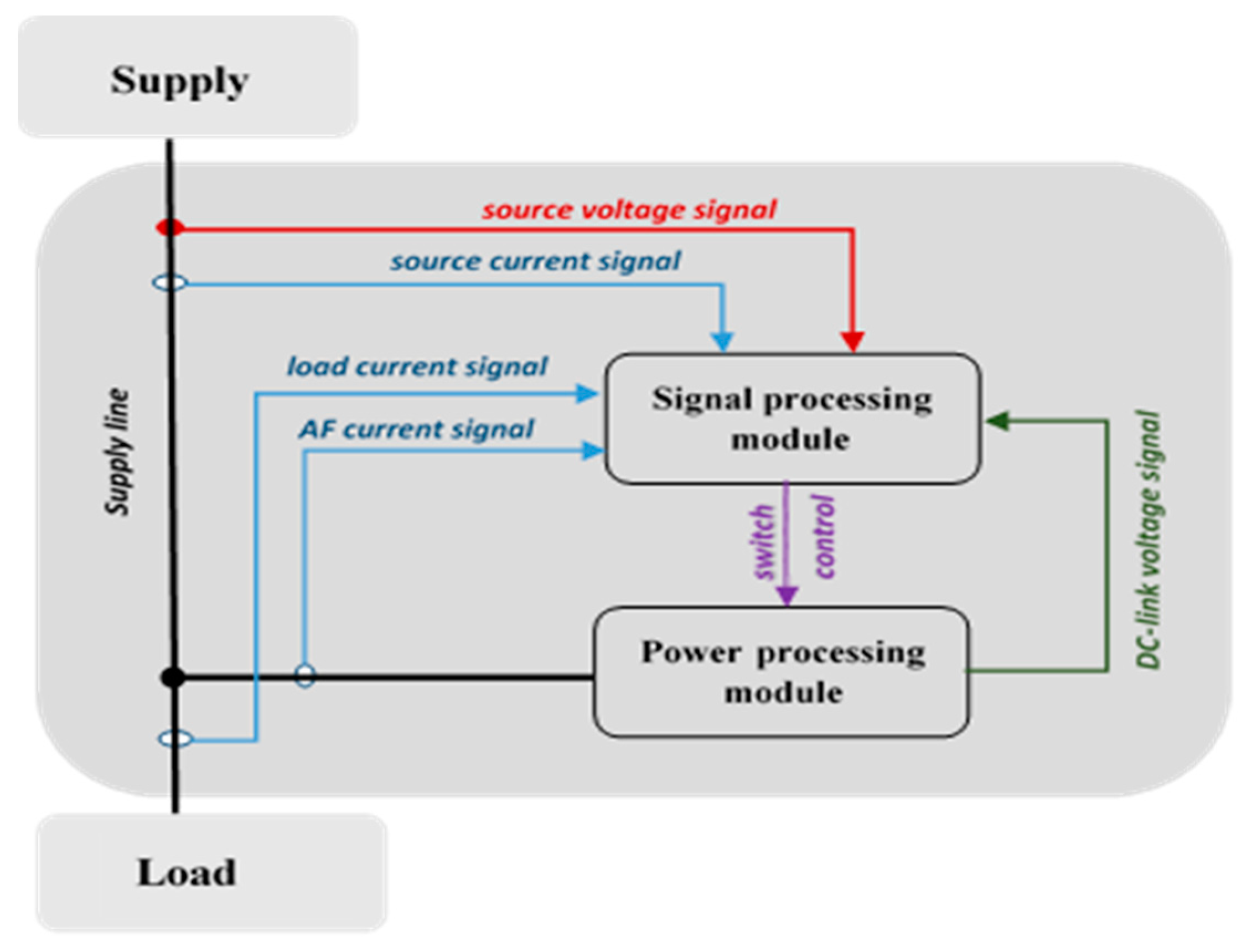
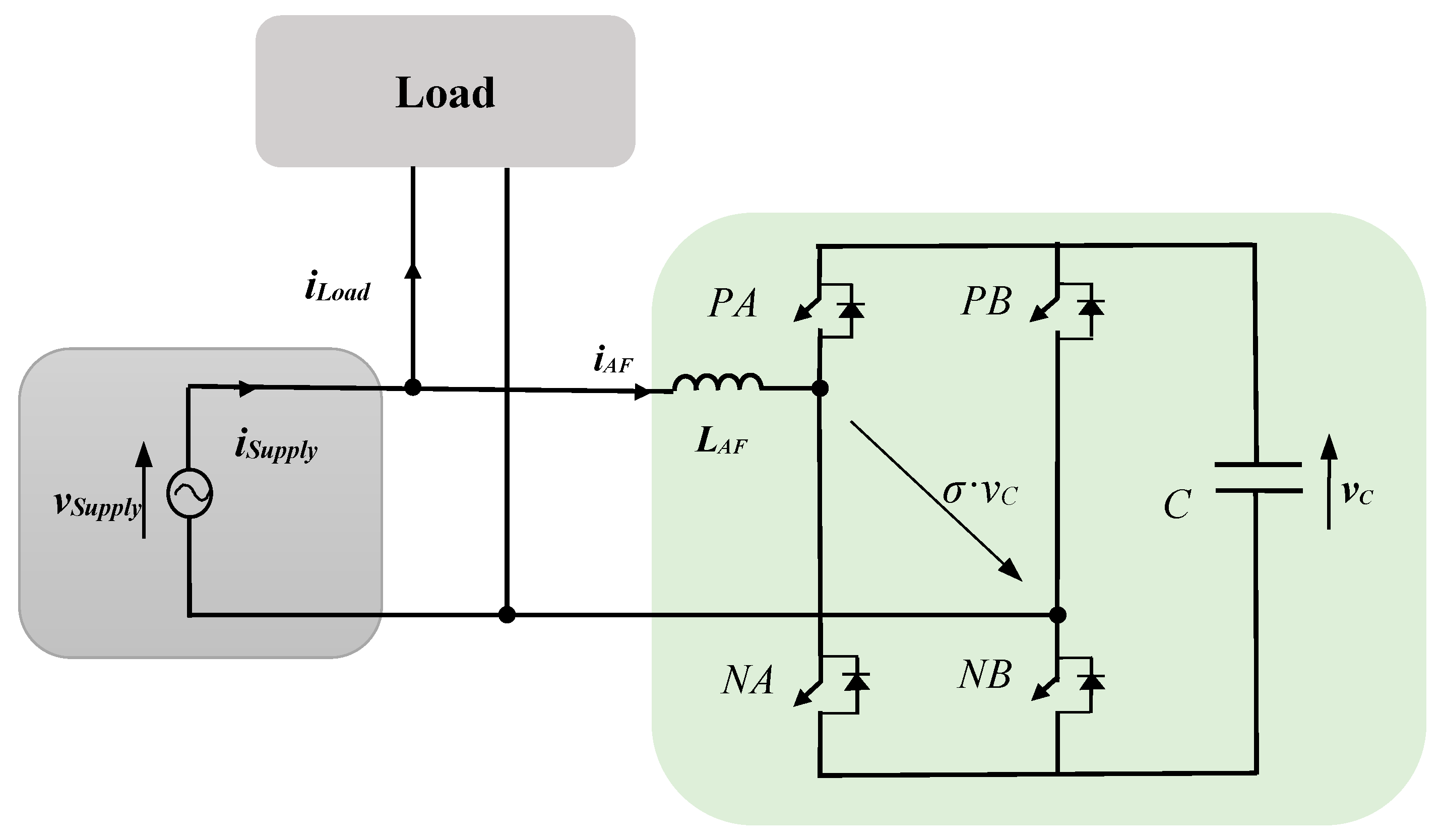
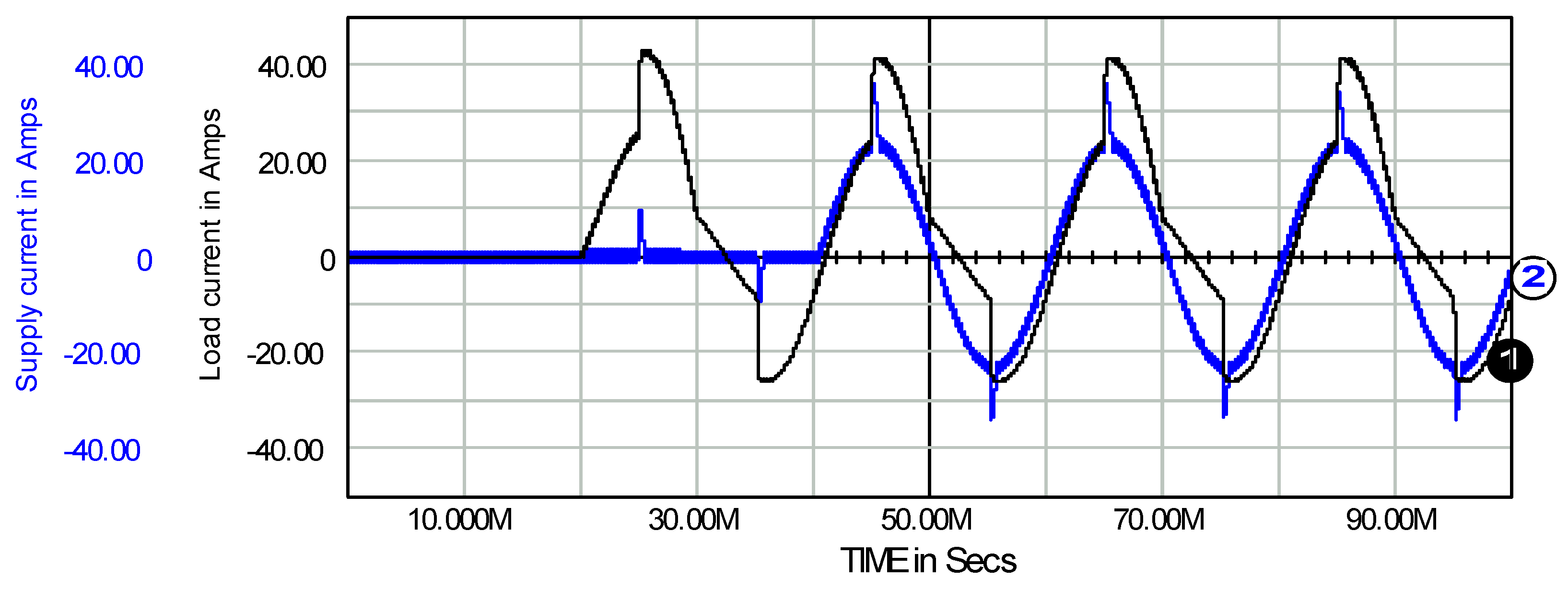

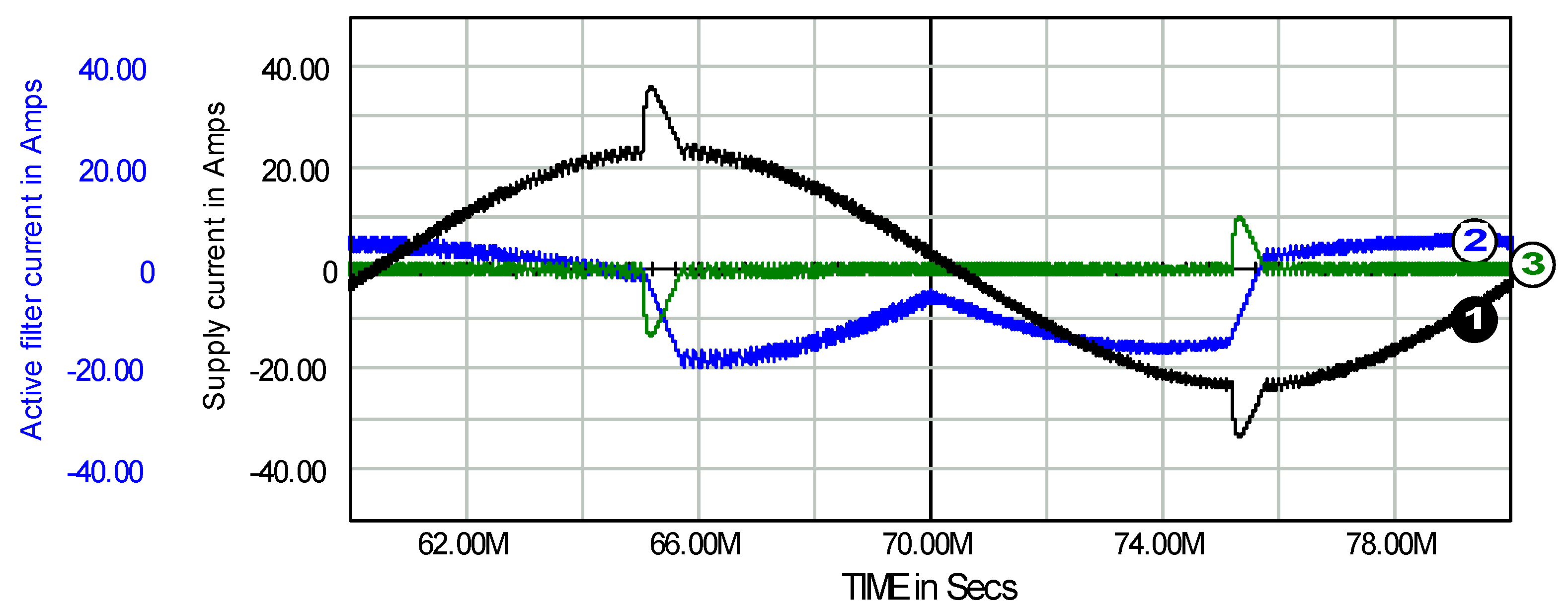
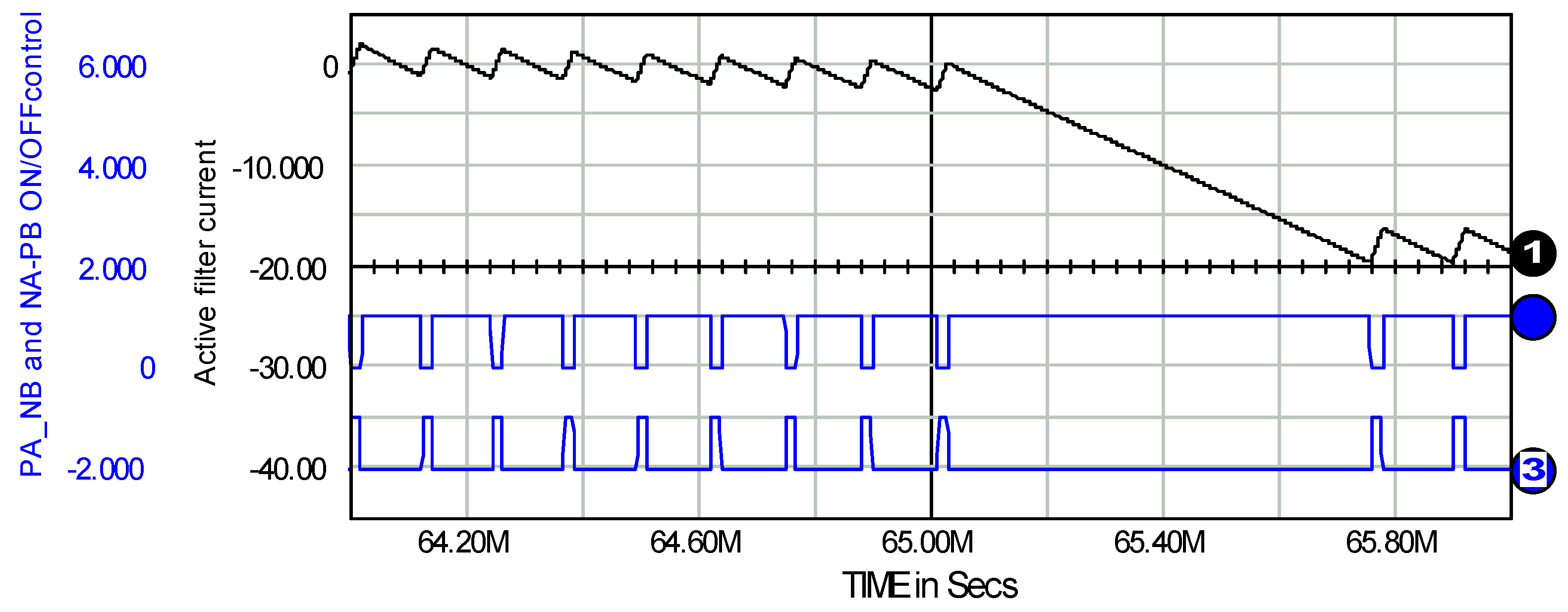
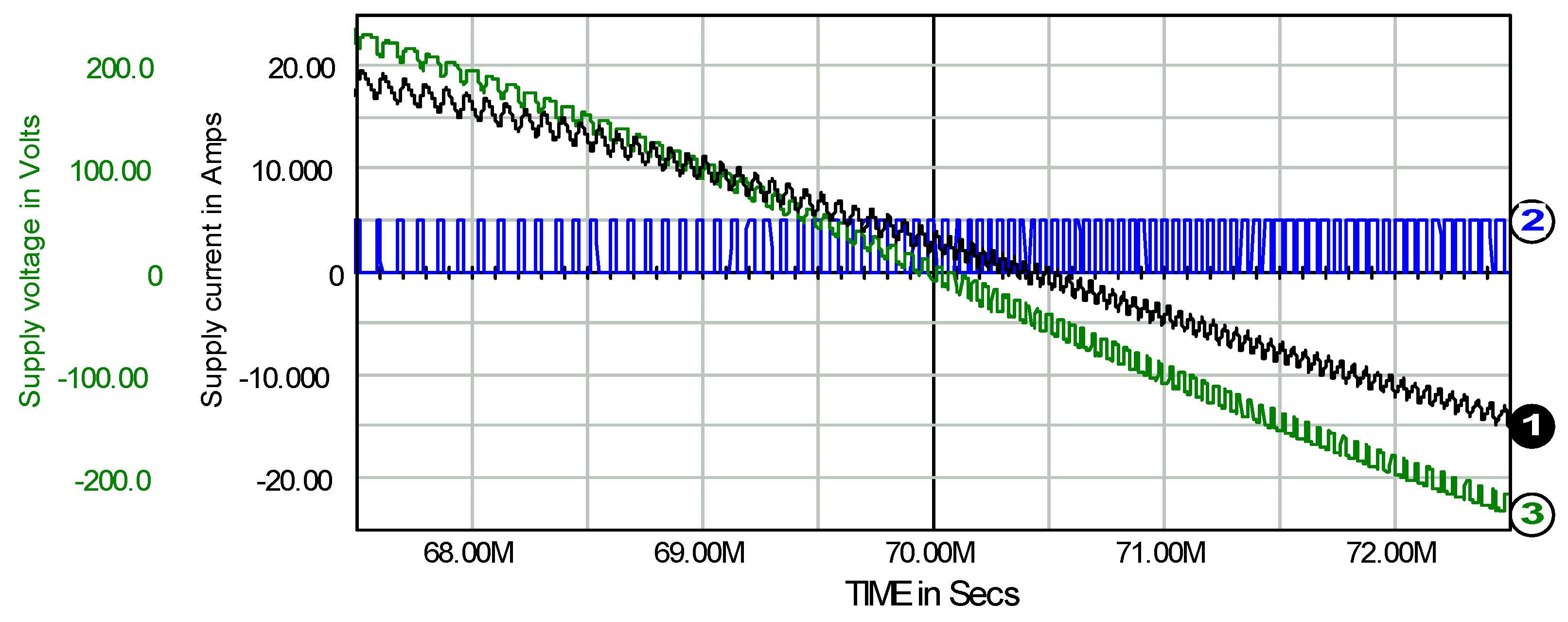

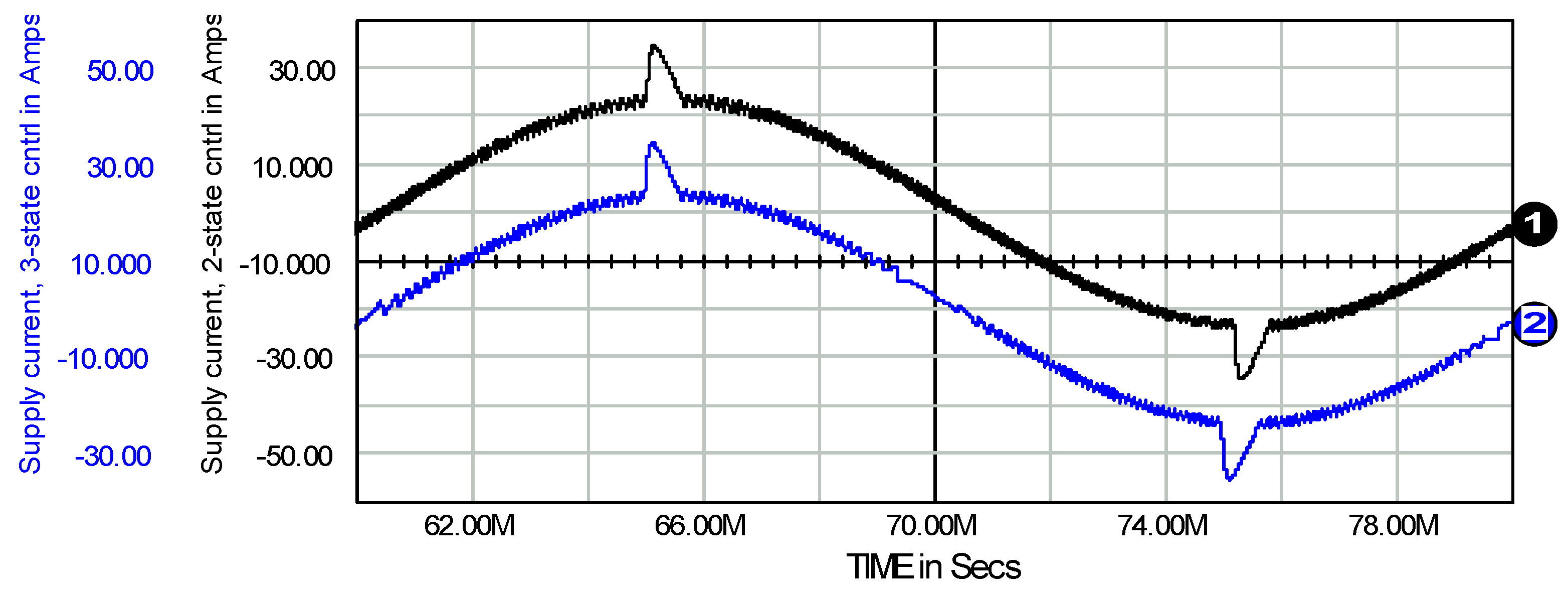
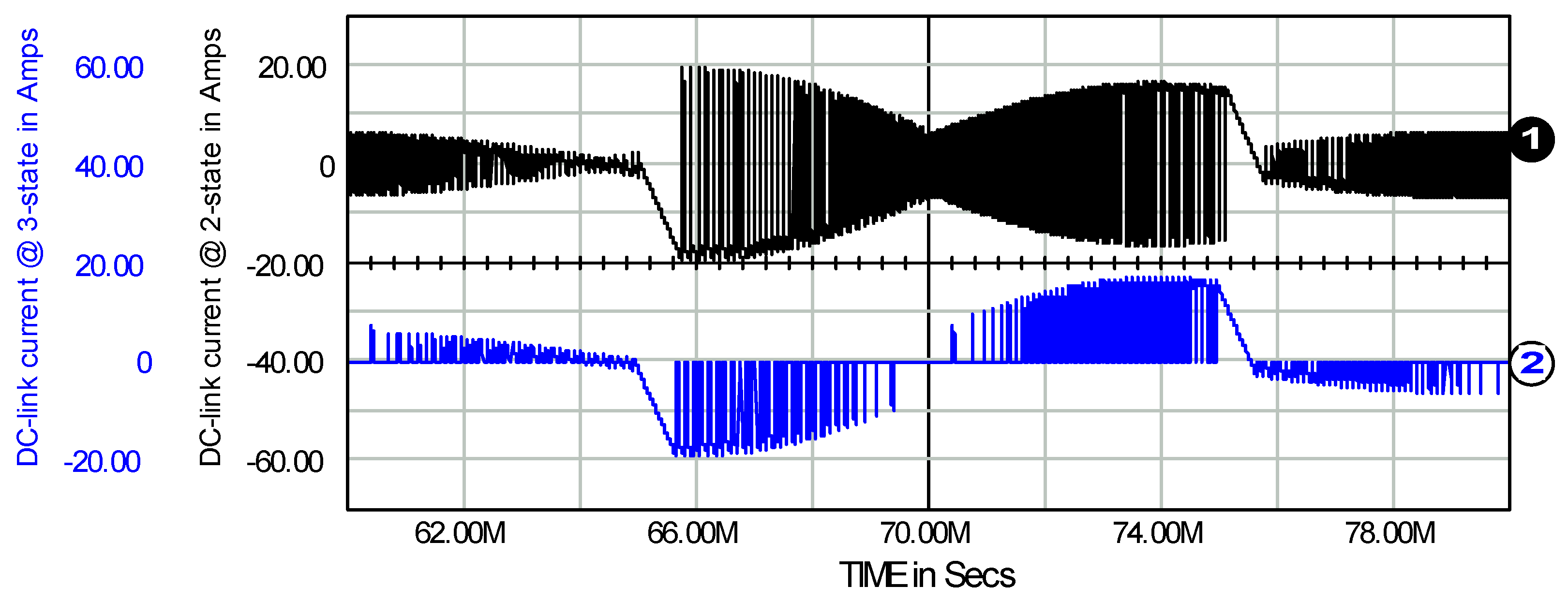

| Control Method | Number of Pulses in Time Period in Milliseconds | Frequency | |||||
|---|---|---|---|---|---|---|---|
| 60–64 ms | 64–68 ms | 68–72 ms | 72–76 ms | 76–80 ms | 60–80 ms | avg(fsw) Hz | |
| 2-state | 49 | 30 | 68 | 47 | 60 | 254 | 12,700 |
| 3-state, 100 V range | 34 | 29 | 36 | 46 | 50 | 195 | 9750 |
| 3-state, 325 V range | 28 | 26 | 20 | 33 | 32 | 139 | 6950 |
| Control Method | Number of Pulses in Time Period in Milliseconds | Frequency | |||||
|---|---|---|---|---|---|---|---|
| 0–4 ms | 4–8 ms | 8–12 ms | 12–16 ms | 16–20 ms | 0–20 ms | avg(fsw) Hz | |
| 2-state | 83 | 65 | 93 | 65 | 81 | 387 | 19,350 |
| 3-state, 100 V range | 57 | 66 | 53 | 65 | 69 | 310 | 15,500 |
| 3-state, 325 V range | 39 | 47 | 27 | 47 | 38 | 198 | 9900 |
Disclaimer/Publisher’s Note: The statements, opinions and data contained in all publications are solely those of the individual author(s) and contributor(s) and not of MDPI and/or the editor(s). MDPI and/or the editor(s) disclaim responsibility for any injury to people or property resulting from any ideas, methods, instructions or products referred to in the content. |
© 2023 by the author. Licensee MDPI, Basel, Switzerland. This article is an open access article distributed under the terms and conditions of the Creative Commons Attribution (CC BY) license (https://creativecommons.org/licenses/by/4.0/).
Share and Cite
Szromba, A. Improving the Efficiency of the Shunt Active Power Filter Acting with the Use of the Hysteresis Current Control Technique. Energies 2023, 16, 4080. https://doi.org/10.3390/en16104080
Szromba A. Improving the Efficiency of the Shunt Active Power Filter Acting with the Use of the Hysteresis Current Control Technique. Energies. 2023; 16(10):4080. https://doi.org/10.3390/en16104080
Chicago/Turabian StyleSzromba, Andrzej. 2023. "Improving the Efficiency of the Shunt Active Power Filter Acting with the Use of the Hysteresis Current Control Technique" Energies 16, no. 10: 4080. https://doi.org/10.3390/en16104080





